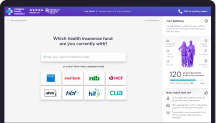Looking at Taking Out Private Health Insurance? Here’s Everything You Need to Know About the Australian Government Rebate on Private Health Insurance.
Are you considering private health insurance? Chances are, you've come across the Australian government rebate on private health insurance rebate . This initiative aims to make private health cover more appealing to Australians by reducing the amount you pay in premiums come tax time.
It's a win-win situation for all as the rebate not only benefits you but also helps alleviate the strain on the public health system (AKA Medicare).
If you meet the criteria, claiming the private health tax rebate is entirely up to you. You have two options: either enjoy reduced premiums throughout the year, or choose to claim the rebate at the end of the financial year when you file your tax return.
In this comprehensive guide, we'll delve into all the details on how you can make the most of the Australian government rebate on private health insurance starting today. We'll provide you with all the necessary information to determine your eligibility and guide you through the process of submitting your claim.
If you feel like you already have a good grasp of the basics and understand the benefits of having a health insurance policy, you can always skip ahead and compare the various options available to you.

Am I eligible for the private health tax rebate?
To be eligible for the rebate, you simply need to fulfil a few requirements:
- Take out approved health cover
- Possess a Medicare card
- Meet the income threshold
The percentage of your rebate will then depend on your income, age of the policy holders and how many dependent children you have.
HOW DOES THE GOVERNMENT REBATE FOR PRIVATE HEALTH INSURANCE WORK?
If you’re trying to work out whether your premiums are eligible for the Australian Government rebate, you’ll need to work out your annual taxable income. This, together with your age and the number of dependent children you have, will help to determine the percentage you’ll receive off your premiums.
The rebate is income tested. This means your eligibility for the rebate depends on your annual income. If you have a higher income, your private health insurance rebate entitlement may be reduced, or you may not be entitled to any rebate at all.
The income thresholds are indexed by the Australian Government. These determine how much rebate you’ll receive off your premiums or as a tax offset. The current rebate levels are applicable to 30 June 2025 and can be found in the table below.
Single parents and couples (including those who are in a de facto relationship) fall under the family thresholds.
| Family Status | Base Tier | Tier 1 | Tier 2 | Tier 3 |
|---|---|---|---|---|
| Single | $97,000 or less | $97,001 - $113,000 | $113,001 - $151,000 | $151,001 or more |
| Family | $194,000 or less | $194,001 - $226,000 | $226,001 - $302,000 | $302,001 or more |
| Singles | ≤ $97,000 | $97,001 - $113,000 | $113,001 - $151,000 | ≥ $151,001 |
| Families | ≤ $194,000 | $194,001 - $226,000 | $226,001 - $302,000 | ≥ $302,001 |
| Rebate | ||||
| Base Tier | Tier 1 | Tier 2 | Tier 3 | |
| < age 65 | 24.608% | 16.405% | 8.202% | 0% |
| Age 65-69 | 28.710% | 20.507% | 12.303% | 0% |
| Age 70+ | 32.812% | 24.608% | 16.405% | 0% |
How often do the Australian Government Rebates change?
The current income threshold structure is fixed until 30 June 2024. The rebate percentages applied are adjusted annually in response to the average cost of health cover premiums and the changes to the cost of living.
How do I calculate my income and rebate?
You’ll need to use your income for the Medicare Levy Surcharge to determine your tax entitlements. This can be easily calculated using the Australian Taxation Office online tools: To use the Medicare Levy Calculator, click here. For the Private Health Insurance Rebate Calculator, click here. You can also contact the Australian Taxation Office (ATO) on 132 861 for further assistance.
How do I claim the Australian Government rebate?
Read through the following overview so you can easily understand how to claim your insurance tax rebate by:
1. Claiming through your health fund
One of the most popular ways to claim the rebate is through your health fund to reduce the costs of your premiums.
To do this, when you purchase your health cover, select the appropriate income and age group tier. Your rebate will then be automatically applied against your premiums.
If you have an existing private health insurance policy and want to reduce your premiums using the rebate, you can contact your health fund to authorize them to do so or submit a Medicare rebate claim form.
2. Claiming with your tax return
Some people choose to claim their rebate entitlement at the end of the financial year to be used as a tax offset.
If you choose this method, you’ll claim through your tax return instead of paying reduced premiums.
By claiming at the end of the year, you won’t be required to nominate an income tier with your health fund.
Completing your policy details on your tax return
Completing your tax return with your private health insurance details is relatively straightforward. All you need is your policy statement provided to you by your health fund at the end of the financial year.
Simply write the amount found on the statement and copy it onto your tax return in the Your Australian Government rebate field.
If you complete the details of your private health insurance correctly on your tax return, you’ll prevent any delays in the processing of your rebate and ensure you receive the correct payment.
KEY POINTS YOU NEED TO KNOW ABOUT THE GOVERNMENT REBATE THRESHOLDS
When determining if your premiums are eligible for the Australian government rebate, there are a few things to consider.

The income used to determine the rebate

The number of dependent children
If you have dependent children, your rebate threshold will increase. This includes any children under 18 years old. Any child under 25 years old who doesn’t have a partner will also be deemed a dependent.
The rebate threshold will increase by $1,500 for each dependent child after your first. If you have three children for example, your income threshold will increase by $3,000.

Singles and couples fall under the family threshold

Age is determined by the oldest policy member

THE REBATE WILL APPLY TO A VARIETY OF POLICIES
You can buy any level of hospital cover, extras cover, ambulance cover, or combined cover from a registered Australian health fund to be eligible for the tax rebate.
This means you could take out a basic level of hospital cover with premiums just a little bit more or the same as the rebate.

If you’re an overseas visitor or student, you may not be eligible

Am I eligible for the private health tax rebate?
What if my income tier changes?
If you’ve incorrectly calculated your income or it changes, this could affect you financially at the end of the year. You won’t receive a lot for choosing the wrong tier, but you may have to pay the difference at the end of the financial year.
1. If you claim too high
If you’ve claimed in a higher income tier, but earned less than you originally anticipated, this rebate debt will be reflected in your tax return. This means, you may end up paying a higher bill come tax time.
2. If you claim too low
If you have claimed in the lower tier, but come tax time you have been entitled to claim in a higher tier, the gap will be reimbursed to you as an offset. While it might be nice to receive a bonus at the end of the financial year, you could have been using that money to lower your premiums.
What’s next with your health insurance rebate?
If you want to take advantage of the Australian Government rebate for private health insurance, establishing your income tier and finding the best cover for your health needs is the first step.
With our online comparison tool, you can compare a range of hospital, extras, ambulance, or combined cover from health insurance providers.
During the process of selecting your chosen health cover, decide on how you want to claim your rebate.
Claiming your health insurance rebate couldn’t be any easier! Get started today.
If you have any questions or queries with your health cover or how the rebate works, we have friendly staff who are all health insurance experts. You can call one of our team on 1300 806 119
FAQS
How can I claim the Australian Government Rebate on Private Health Insurance?
You have two options for claiming the rebate. You can either choose to receive reduced premiums throughout the year by having the rebate applied directly to your insurance premiums, or you can claim the rebate as a tax offset when you file your annual tax return.
How is the rebate amount determined?
The rebate amount depends on factors such as your annual taxable income, age, and the number of dependent children you have. The Australian Government sets income thresholds that determine the percentage of rebate you'll receive off your premiums. The rebate levels are adjusted annually based on the average cost of health cover premiums and changes in the cost of living.
What is Lifetime Health Cover (LHC) loading, and how does it relate to the rebate?
Lifetime Health Cover loading is a financial loading that can be applied to your private health insurance premiums if you don't take out hospital cover before the age of 31. The LHC loading is separate from the rebate and is not affected by your eligibility or rebate tier.
Where can I find more information about the rebate and private health insurance?
For detailed information about the Australian Government Rebate on Private Health Insurance, you can visit the Australian Taxation Office (ATO) website at www.ato.gov.au. They provide comprehensive information on eligibility, rebate tiers, income thresholds, and how to claim the rebate.
Do the rebate tiers apply to individuals or families?
The rebate tiers apply to families, including both couples and single parents, and are determined based on family income. The family income includes the combined income of the policyholder and their spouse/partner. The age of the oldest policy member also determines the family rebate threshold.









